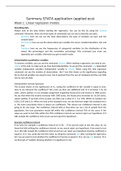College aantekeningen
Summary Stata application videos applied microeconometrics
This is the summary of the stata application part of applied microeconometrics. Together with the theoretical summary I got an average of 8,5 on my exam and assignments.
[Meer zien]




